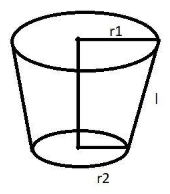
STATEMENT – 1: The slant height of frustum of cone is 4cm. and perimeter of its circular ends are 18 cm, and 6 cm, then the curved surface area is 48 sq. cm.
STATEMENT – 2: Curved surface area of frustum is $\pi \left( {{r_1} + {r_2}} \right)$ where ${r_1}{\text{ and }}{{\text{r}}_2}$ are the radii of the frustum and l is the slant height.
$
(a){\text{ Statement - 1 is True, Statement - 2 is True, Statement - 2 is a correct explanation for statement - 1}}{\text{.}} \\
(b){\text{ Statement - 1 is True, Statement - 2 is True, Statement - 2 is not a correct explanation for statement - 1}}{\text{.}} \\
(c){\text{ Statement - 1 is True, Statement - 2 is False}} \\
(d){\text{ Statement - 1 is False, Statement - 2 is True}} \\
$
Answer
613.2k+ views
Hint: In this question use the direct formula for the curved surface area of frustum of cone. Curved surface area of frustum of cone$\pi \left( {{r_1} + {r_2}} \right)l$.
Complete step-by-step answer:

As we know that the curved surface area (C.S.A) of the frustum is $\pi \left( {{r_1} + {r_2}} \right)l$ $cm^2$………… (1)
Where r2 and r1 are the radius of lower and upper circular parts.
And l = slant height of the frustum.
So from the above formula of the curved surface area of the frustum clearly that statement – 2 is false as in statement 2 slant height is not present in the formula.
Now according to statement – 1 it is given that slant height (l) = 4 cm.
And the perimeter of the circular ends are 18 and 6 cm respectively.
As we know that the perimeter of a circle is$2\pi r$, where r is the radius of the circle.
So the upper circular part of the circle perimeter is $2\pi {r_1}$
$ \Rightarrow 2\pi {r_1} = 18$
$ \Rightarrow {r_1} = \dfrac{{18}}{{2\pi }}$ cm.
Now the lower circular part of the circle perimeter is $2\pi {r_2}$
$ \Rightarrow 2\pi {r_2} = 6$
$ \Rightarrow {r_2} = \dfrac{6}{{2\pi }}$ cm.
So from equation (1) we have,
$ \Rightarrow C.S.A = \pi \left( {{r_1} + {r_2}} \right)l$
Now substitute all the values in this equation we have,
$ \Rightarrow C.S.A = \pi \left( {\dfrac{{18}}{{2\pi }} + \dfrac{6}{{2\pi }}} \right)4 = \pi \left( {\dfrac{{24}}{{2\pi }}} \right)4 = 12 \times 4 = 48$ sq. cm.
Thus statement – 1 is true.
So statement – 1 is true, statement – 2 is false.
Hence option (c) is correct.
Note: Whenever we face such types of problems the key concept is to have a gist of the direct formula of some of the basic conic sections like frustum of cone, sphere, cylindrical etc. This helps save a lot of time while solving such types of problems.
Complete step-by-step answer:

As we know that the curved surface area (C.S.A) of the frustum is $\pi \left( {{r_1} + {r_2}} \right)l$ $cm^2$………… (1)
Where r2 and r1 are the radius of lower and upper circular parts.
And l = slant height of the frustum.
So from the above formula of the curved surface area of the frustum clearly that statement – 2 is false as in statement 2 slant height is not present in the formula.
Now according to statement – 1 it is given that slant height (l) = 4 cm.
And the perimeter of the circular ends are 18 and 6 cm respectively.
As we know that the perimeter of a circle is$2\pi r$, where r is the radius of the circle.
So the upper circular part of the circle perimeter is $2\pi {r_1}$
$ \Rightarrow 2\pi {r_1} = 18$
$ \Rightarrow {r_1} = \dfrac{{18}}{{2\pi }}$ cm.
Now the lower circular part of the circle perimeter is $2\pi {r_2}$
$ \Rightarrow 2\pi {r_2} = 6$
$ \Rightarrow {r_2} = \dfrac{6}{{2\pi }}$ cm.
So from equation (1) we have,
$ \Rightarrow C.S.A = \pi \left( {{r_1} + {r_2}} \right)l$
Now substitute all the values in this equation we have,
$ \Rightarrow C.S.A = \pi \left( {\dfrac{{18}}{{2\pi }} + \dfrac{6}{{2\pi }}} \right)4 = \pi \left( {\dfrac{{24}}{{2\pi }}} \right)4 = 12 \times 4 = 48$ sq. cm.
Thus statement – 1 is true.
So statement – 1 is true, statement – 2 is false.
Hence option (c) is correct.
Note: Whenever we face such types of problems the key concept is to have a gist of the direct formula of some of the basic conic sections like frustum of cone, sphere, cylindrical etc. This helps save a lot of time while solving such types of problems.
Recently Updated Pages
Master Class 10 Computer Science: Engaging Questions & Answers for Success

Master Class 10 General Knowledge: Engaging Questions & Answers for Success

Master Class 10 English: Engaging Questions & Answers for Success

Master Class 10 Maths: Engaging Questions & Answers for Success

Master Class 10 Science: Engaging Questions & Answers for Success

Master Class 10 Social Science: Engaging Questions & Answers for Success

Trending doubts
The average rainfall in India is A 105cm B 90cm C 120cm class 10 biology CBSE

Why is there a time difference of about 5 hours between class 10 social science CBSE

What is the median of the first 10 natural numbers class 10 maths CBSE

Who Won 36 Oscar Awards? Record Holder Revealed

Write a letter to the principal requesting him to grant class 10 english CBSE

The Equation xxx + 2 is Satisfied when x is Equal to Class 10 Maths




